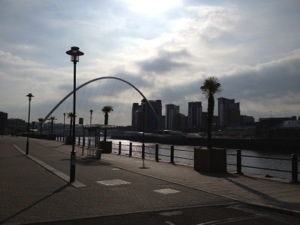A writer, a photographer, a poet and a painter walk along a river…
Sounds like the start of a particularly esoteric joke, but it is in fact the premise for Tyne View, a fantastic book by Michael Chaplin which, late as ever to the party, I have only just got round to reading. Having read it, I feel the urge to recommend as many people as possible to follow suit.
As ever with the best in many fields, the book has a simple premise. In the summer of 2011, Chaplin, a writer for TV and radio for many years, together with photographer Charlie Bell, Tynedale poet Christy Ducker and artist Birtley Aris took a walk up and down the tidal length of the River Tyne from South Shields to Wylam then back down the North bank to end at Tynemouth. Along the way of this fairly leisurely paced 10-day trek they would record what they had seen, who they had met and what they had learned.
Ostensibly the project came under the auspices of the Port of Tyne, the organisation whose jurisdiction along the river matches that of the route of the walkers. Amongst many other things, Michael Chaplin is the writer-in-residence at the Port and by the evidence of Tyne View it is a match made in literary heaven.
I’ve previously been more than a little sceptical of writers or artists in residence programmes, which tend to produce either indifferent if well-meaning works of art or are fatally compromised by a heavy-handed approach by the sponsoring company or organisation who are overly keen to get their money’s worth by plastering their name all over the work produced.
Happily for all concerned, Tyne View falls into neither trap. Port of Tyne deserve huge praise for letting their man get on with things, realising that letting such a talented writer do his thing will reflect extremely well on them and their organisation and Chaplin is in positively inspired form throughout, writing about a landscape and people he clearly loves.
However, while his love of place shines through in every page, it is rare to have someone who can write so lyrically without ever lapsing into sentimentality – Chaplin’s description of listening to Jimmy Nail’s rather misty-eyed paean to the Tyne’s glory days “Big River” as “rather like eating too much chocolate” is typical of his gently robust approach.
Chaplin is also extremely adept at sneaking facts past you without you even noticing. I learned more in the 350-odd pages about the Tyne than I would’ve done in a lifetime of lectures – and thoroughly enjoyed the process too. Some of the figures involved are staggering: for instance, at it’s height, the mighty Armstrong works in Scotswood employed 78,000 people. Yes, you did read that right. That’s like one and a half St James’s Parks all working at the same place.
Another fact that comes through is what a mix Tynesiders are made up of. To the outsider, the area’s strong sense of culture and tradition may make it seem like its people have been there since time immemorial. In actual fact, its inhabitants’ ancestors came from the West Country, Scotland, Ireland, Scandinavia, the Yemen and elsewhere – all attracted by the prospect of work in a thriving industrial area. The irony is palpable, yet as Tyne View makes clear on a number of occasions, reports of the River’s demise in that direction are greatly exaggerated.
The other key factor in Tyne View’s success is that although he expresses himself beautifully as a writer, Chaplin has not lost his journalist’s instinct to be nosy (in the nicest possible way) and to talk to people and get their views. Many a travel book (and this is essentially what Tyne View is) has been ruined by a writer pontificating on a scene he comes across without ever interacting with it. By contrast, Chaplin and company just get stuck in and are rewarded with some fantastic encounters as a result.
The “company” bit in this is not to be underestimated – Tyne View is a great looking book to have around as well as read. Charlie Bell’s photographs succeed not just in setting the scene and capturing the personalities of their subjects, they also make you look at familiar things in a new light – no easy trick, I can tell you. Birtley Aris’ impressionistic paintings add a timeless quality to the book while Christy Ducker’s poetic responses to the sights and sounds of the Tyne would make a very fine collection in their own right.
Add all this up and you have not only one of the most enjoyable books I have read in a long time but also a true work of art.
What’s more, the story does not end there. Chaplin has since written an acclaimed play inspired by the book – Tyne View was performed to much acclaim at Newcastle’s Live Theatre earlier this summer.
Once more late to the party, it had finished its run before I could get a ticket. However, moves are afoot to bring the play back next spring, fittingly to locations on both sides of the Tyne (the Customs House in South Shields and the Theatre Royal in Newcastle).
If it’s anything like the book, this time I’ll be first in the queue.

